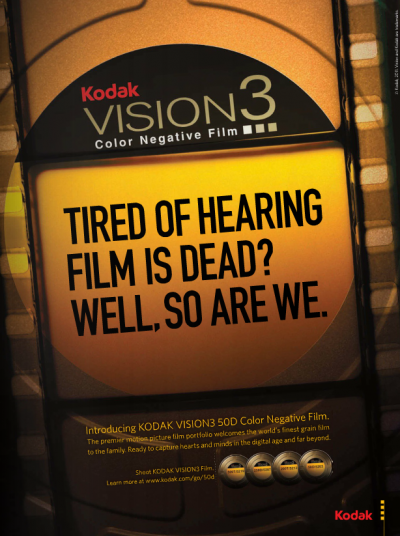UPDATED 19th January 2012: Kodak today filed for bankruptcy protection. Read the Reuters report here.
Various outlets have reported recently that Kodak is preparing for a Chapter 11 bankruptcy protection filing. At this stage the company is hoping to sell off some of its digital patent portfolio to raise extra funds and avoid bankruptcy.
But today Reuters/AFP are reporting that Eastman Kodak is splitting into two business segments from the present three, one focused on the general public and the other on professionals.
Phillip Faraci will head the commercial segment, while Laura Quatela will head the consumer segment. Both executives will have the title of co-president and chief operating officer and will report to chairman and chief executive Antonio Perez.

Last week, Kodak warned investors it might be kicked off the New York Stock Exchange if it could not boost its share price in the next six months. Under the structural changes, which came into effect on January 1, the company’s commercial and consumer segments have absorbed the businesses that had held the film, photofinishing and entertainment group. That group was being phased out and its head will move to the newly named commercial business.
The commercial segment will include the graphic communications group and take on the entertainment imaging and commercial film businesses. The consumer business will include the consumer digital imaging group as well as businesses from the old film and photofinishing unit, reports Reuters.
Kodak is, of course, an innovator in the film, camera and digital markets, even inventing the digital camera in 1975. For many years the company has been a key player in the filmmaking and visual effects fields, but more recently has struggled to adapt to constantly changing technology.
Ironically, in the latest issue of American Cinematographer magazine, Kodak ran a full page advertisement for its Vision3 50D color negative film, asking: ‘Tired of hearing film is dead? Well, so are we.’
Sadly, in 1996 Kodak shares topped $US80, but today they closed 50% higher to US $0.60.
And…the 131 year old Eastman Kodak Co. company is also suing Apple today, hoping to use its patent portfolio into additional revenue, according to Susan Decker of Bloomberg. Kodak is claiming infringement of technology related to digital photographs, related to Apple’s iPad 2, iPhone and iPod Touch. We also sought comment from visual effects house Cinesite, a wholly-owned subsidiary of Kodak on the fate of Kodak. Although they were unable to discuss the possible bankruptcy filing or corporate level restructurings, Cinesite explained that they themselves had very strong plans for growth in 2012, saying:
‘We’ve just delivered John Carter and are currently working on the latest Bond film Skyfall and World War Z.’
This is good news for one of the most successful London VFX shops, which has an important presence in the visual effects community from both an employment and technical innovation in our industry.

Are you sad about Kodak? Many of us built our careers using Kodak film – or do we just not feel loyalty to Kodak like we do to other Industry brands – and if so why? Tell us your thoughts.
Does anybody knows what’s going to happen with Kodak Cinelabs?
…as an aside, Technicolor have closed their photochemical labs in London, Rome and Madrid.
Even if Kodak would have to file for chapter 11, I don’t think it would be the end of their production of motion picture film. Many key people are fortunately still backing this important medium. I, too, believe that there is still no digital equivalent to film. Sure, digital capture has come a long way, but film stocks have improved as well. Within a few seconds or less I notice when a moving image was acquired digitally. I don’t think I’m special in this, I’m sure most of you can identify the very camera/lenses used. The thing is, it’s the deficiencies of digital that so obviously stand out. We all know what they are and that some are intrinsic to the technology. Last year’s Academy Award for Best Cinematography went to the 65mm “Inception”, and not to RED’s “The Social Network”. Likewise “Ghost Protocol”, also on 65mm, is doing great in the box office. Seems I’m not the only one who cares about image quality. As long as audiences and filmmakers continue to demand film, I think its survival will be ensured.